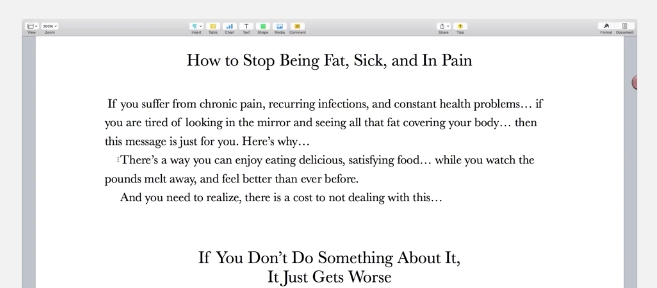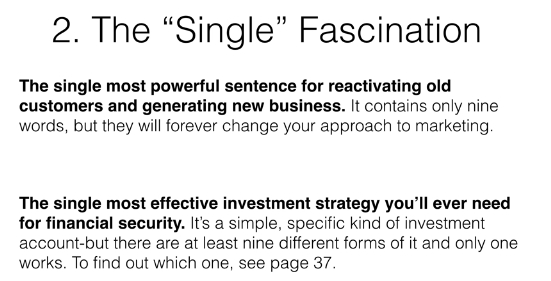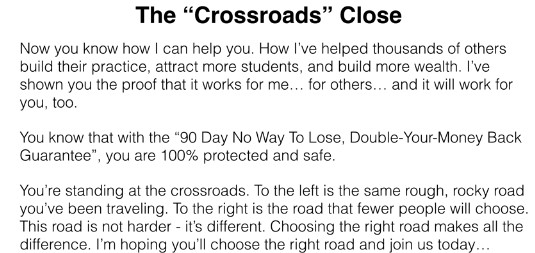Copywriting is by far the most lucrative form of writing there is. Aside from authoring a best-selling novel, your best bet for making money with writing and becoming a six-figure writer is to become adept at copywriting.
- Inbox Dollars - Get paid to check your email. $5 bonus just for signing up!
- Survey Junkie - The #1 survey site that doesn't suck. Short surveys, high payouts, simply the best.
- Nielsen - Download their app and get paid $50!
And it’s not just professional copywriters who copywrite. If you’ve ever written a letter to a friend inviting him to dinner, or if you’ve ever written your boss her asking for a raise, you’ve engaged in copywriting.
In a nutshell, copywriting attempts to exchange one object of value for another- and that object need not necessarily be money. The process of selling, which is what copywriting attempts to do, can involve physical objects, services or time. You can even sell people- consider how the profile pages of online dating sites are essentially sales pages for the advertised good (i.e., the person).
However, just because you know how to write doesn’t mean you know how to copywrite. That’s because copywriting follows a defined pattern of presentation and persuasion, and so the most talented copywriters often require years of training and on-the-job experience.
Luckily, you can quickly advance in the field of copywriting if you understand its principles and train with recognized leaders in the field.
Enter Ray Edwards, an accomplished copywriter with years of experience in the field of effective copywriting. Ray has recently launched Copywriting Academy, which promises to train novice and even advanced copywriters in the art of writing successful copy.
Ray had granted I’ve Tried That complimentary access to the program. I recently went through and reviewed Ray’s course, which is divided into eight lessons as well as additional bonuses and coaching calls. As an established copywriter myself, I still found Ray’s material to be educational and informative. I provide a synopsis of each of his lessons below.
Copywriting Academy- Writing Words that Sell
Module 1: The Quickstart
Lesson 1: Objectives for this Module
What is copywriting? Why is copywriting so important? How do you structure a sales message? These are the questions that Ray asks in this initial video. He also prepares you to write your first sales page- and one that’ll actually make you money from the get-go.
Lesson 2: Why is Copywriting so Important?
Selling is all around us, whether we’re aware of it or not. There’s always a sale taking place, whether it’s your kids trying to convince you to stay up later or your spouse convincing you to take a vacation at a particular destination. Even if no money changes hands, selling is everywhere.
Copywriting isn’t just about selling stuff; it’s about the art of persuasion. Writing to sell just takes the art of persuasion and puts it into words.
Lesson 3: How to Structure a Sales Message
Ray introduces the P.A.S.T.O.R. acronym, which stands for the following phases of creating a sales message:
P= Problem (identify the customer’s problem/pain)
A= Amplify (the consequences of not solving the problem)
S= Story (descriptor of how you came upon the problem’s solution)
T= Testimony (how your solution worked for others)
O= Offer (focus on the promised transformation, not deliverables)
R= Response (how to order or buy)
Ray also shows a worksheet that takes you through the process of creating a PASTOR sales page. He provides an example of how one might structure a sales page to sell a copywriting workshop.
Lesson 4: Structure a Sales Message
Ray provides a second example of how one might sell a smoothie recipe book using the PASTOR template. He starts with the problem, amplifies it, then provides the solution (the smoothie), and finally wraps up his second example with a way to sell this product.
Module 2: Irresistible Offers
Lesson 1: Session Objectives
‘Making an offer you can’t refuse’ is key to creating an offer that sells. What an offer really is, why offers are so important, and how to structure an offer are the key concepts that Ray presents.
Ray follows up with several examples of how accomplished copywriters created irresistible offers.
Lesson 2: The 9 Kinds of Offers
Ray introduces the advantages and disadvantages of the nine main types of sales offers. They are the following:
- The hard offer (Here’s what we offer; buy now.)
- The soft offer (e.g., Send no money now.)
- The charter offer (first-time product is offered at special/reduced rate)
- Limited supply offer (keep your word)
- Limited time offer (again, keep your word)
- Application offer (an elite offer where customers must first apply to obtain offer)
- Payment plan offer (makes the high price more palatable)
- One-time offer (often an up-sell or cross-sell)
- Negative option offer (i.e., subscription plan and controversial)
Ray then discusses which offer to present to customers based on their level of awareness. There are four levels of awareness, and each one requires a different offer.
Lesson 3: The 6-Step System for Writing an Offer
There are six steps involved in writing an effective offer. They are Who, What, When, Where, Why and How.
Who: Who is your buyer, and who are you that you qualify to present this offer to your customer?
What: What are you actually selling, and what will the product do for the customer?
When: When will the copy run, and when will prospects be most likely to buy?
Where: Where will prospects come from to your copy- from an email, webinar, etc.? Where will your copy live, and where will your product be located?
Why: Why is this product a good fit for your customers?
How: How will your product transform the lives of your customers? And how will they pay you?
Ray presents the three power moves for a stronger offers: Clear offer, clear copy, clear results. He also advises proofreading your copy by actually reading it out loud, and preferably, to another human being.
Lesson 4: Write Your Offer!
It’s homework time: Ray provides you with Your Powerful Offer Checklist in Pages format for Mac, PDF, and MS Word. Herein, you assess your offer and its transformational benefit, the awareness stage of your customer, and which offer you plan to use. Ray’s checklist also has you go through the 6-step system for writing an offer.
No joke. Here are the fastest ways to make easy money online. Click here to see how.
Before you become too intimidated by the homework, Ray fills out his own checklist using the example of debt reduction. He provides short and sweet fill-in-the-blank answers and shows you exactly how you might fill out this form.
Module 3: Persuasion Blueprint
Lesson 1: The PASTOR Framework
Ray goes into greater detail regarding the PASTOR framework introduced in Module 1. He discusses how every sellable item, even art, fashion or a vacation, solves a problem. Maslow’s hierarchy of needs is introduced as the psychological basis of selling even “luxury” goods.
Ray also discusses how helping consumers avoid undesirable consequences can also be viewed as satisfying their needs.
Lesson 2: The Buyer’s Journey
Joseph Campbell’s “The Hero’s Journey” is used as the backdrop for explaining how a copywriter must create a universal story and temporarily suspend (customer) disbelief. Ray presents several examples of universal stories portraying a hero and his journey (e.g., Batman, The Lord of the Rings). One such hero is Luke Skywalker, who is helped by his wise guide, Yoda. Ray emphasizes that copywriters often envision themselves as the hero of their story; however, this is incorrect.
Obviously, if your customer views herself as the hero, she will more likely heed your wise advice and buy your product.
Ray offers all the stages of the buyer’s journey as a downloadable and printable poster in the members’ area.
Lesson 3: How PASTOR and The “Buyer’s Journey” Work Together
Ray describes how the PASTOR format and the Buyer’s Journey fit each other using this illustration:
Lesson 4: The Sales Copy Template
Ray presents his long-awaited sales copy template, which he states can be “used to sell a product where people aspire to an outcome that so far has escaped them.” Ray then spends roughly 15 minutes going over his template and filling it in with example copy.
This lesson concludes with homework wherein you are asked to go over this lesson a second time and fill in the template using your own copy for your own product. Ray also asks that you take a break (for a day, or even a week) and later re-write your copy in order to see it with a fresh eye.
Lesson 5: The Sales Copy Checklist
Before you head off to do your homework, Ray offers a 21-point checklist for you to use so that you don’t forget any critical features of your message. Here are just some of these points:
Module 4: Headlines and Subheads
Lesson 1: The Importance of Headlines and Subheads
Ray emphasizes that a good sales page has both effective headlines and subheads (sub-headlines). A good headline (and subhead) not only grabs the reader’s attention, it also gets him to read the next sentence. Good headlines are on target, emotional, novel, and unexpected.
Lesson 2: Different Kinds of Headlines and Subheads
Headlines introduce the overall topic of the copy, and the subheads stop the reader from getting lost in the copy by segmenting it. Ray advises keeping headlines short yet emotional, and to make sure they cultivate curiosity in the reader. He also notes that the best headlines seduce the reader and ask leading questions. Several different examples of excellent headlines are provided.
Lesson 3: 21 Proven Headline Templates
As advertised, Ray provides 21 different headline templates that you can take and run with while creating your own copy. Some example headline templates include the “How to,” the “Top 10 Reasons,” the “Amazing Secrets,” the “Which Mistakes,” and the “Hidden Truth” headlines.
Lesson 4: Cool Tools & One Ninja Trick
If you’re still at a loss about how to create good headlines, there are online tools to help you out. Ray first takes you to HubSpot’s Blog Topic Generator and shows you how to use it to generate “blog topicy” headline ideas.
Other headline generators include Portent’s Content Idea Generator. Ray also shows you how to locate magazine covers and adapt their headlines to your marketing purposes.
You can make money from home and it doesn't have to be challenging. Click here to see how.
Homework for this lesson includes creating 100 headlines using the provided templates.
Module 5: Fascination Factor
Lesson 1: The Magnetic Selling Power of Persuasion Points
Persuasion points that compel people to buy your product are an absolute necessity in successful copywriting and are termed fascination factors by Ray. They also often appear as bullet point copy. Some example fascination factors include the following:
- What never to eat on an airplane.
- Should you give up your web page in exchange for a Facebook fan page?
- The three items you should never include in a book proposal.
Lesson 2: Styles of Persuasion Points
In this lesson, Ray introduces three types of persuasion points, namely:
- Blind persuasion fascination (completely hides the secret)
- Giveaway fascination (gives the reader something that immediately helps)
- Hybrid fascination (gives a partial explanation)
Lesson 3: 21 Persuasion Point Templates
If you’re lost on how to create your own “fascinations,” Ray has 21 templates that you can follow. This uses the same template approach as that seen for generating headlines in Module 4. Here is just one sample of Ray’s fascination templates:
Module 6: Resistance Removal
Lesson 1: The Importance of Guarantees
It’s not enough that you understand your customers, have fully illustrated your product and its benefits, generated powerful fascinations, and wrote magnetic headings and subheads.
No, it’s not enough if you don’t remove the buyer’s fears.
After all, it’s in the buyer’s best interest to not believe your claims and your story. The buyer risks losing his money, feeling hassled and/or stressed, looking foolish, etc.
How do you overcome fear in your buyer? By taking on as much of the risk as possible. This is the reason why X-day money-back guarantees exist.
However, Ray goes way beyond the basic money-back guarantee by describing his unique “Ray’s Way” 10-part guarantee and how you can implement it when selling your own goods and services.
Lesson 2: How to Transform a Weak Guarantee
Ray shows you, step-by-step, how to create a strong guarantee designed to close deals. Or, as he calls it:
Ray goes through an example of a very weak cosmetic dentistry guarantee and changes it into a very bold statement of confidence via “Ray’s Way” 10-part guarantee.
Lesson 3: How to Create “Tipping Point” Bonuses
Psychologically, tipping point bonuses exist to motivate people to buy. In Ray’s words, “Bonuses serve as hesitation busters.”
What makes a good bonus?
- It’s related to the main product(s).
- It makes the rest of the product easier (or even unnecessary).
- Is valuable enough in its own right.
Module 7: Closing the Deal
Lesson 1: Closing Copy: What It Is and Is Not
The purpose of the close is to ask for the sale, obviously. Here is where you recap the offer, repeat why the customer needs to make the purchase, and to remind the customer of the guarantee and the bonuses. Finally, and perhaps most importantly, you want to obtain a yes or no answer.
You must also ask for the sale. This is very important and one of the biggest failures of a good majority of sales copy.
Lesson 2: Closing Templates
Ray presents five closing templates that help generate the final step of the process- the sale. Here is one such template:
Ray then assigns homework, asking that you draft your own closing copy for your already (and mostly complete) draft sales letter.
Module 8: Inbox Magic
Lesson 1: The Power of Email Copy
Email is not dead. In fact, email is still the #1 way to sell online.
Why does email work even in the era of social media and apps? Because it’s personal, it’s ever-present, and because it’s easy to use. Ray emphasizes that, even in today’s world of social media and mobile apps, there is no substitute for tried-and-tested email copy.
Lesson 2: 21 Keys to Emails that Sell
Ray goes over the 21 basics of email marketing, including obtaining subscriber permission when building a list, using a reputable email delivery service, giving people a reason to opt-in, and so on. These keys are intended as an introductory approach to selling via email and not being considered a spammer.
Lesson 3: Email Sequences for Maximum Sales
What sequence of emails should you send? Which sequences are the best? Ray introduces the 3 main types of email campaigns, including live campaign sequences (written as the event is happening), automated campaign sequences (sent via auto-responder), and general broadcasts (one-off emails sent to all).
Major differences between each email campaign are noted, and several resources are noted for additional information. Ray says it goes beyond the scope of this course to talk more about how each email campaign should be set up and run.
But wait…there are bonuses!
It wouldn’t be right if Ray didn’t offer some bonuses to Copywriting Academy members after talking at length about bonuses and how they can create a tipping point for a purchase. So, the following bonuses are offered, but they are by no means the only bonuses available in Copywriting Academy.
Bonus Module 1: The Six Figure Second Income
Ray spends over an hour going over how you can prepare yourself psychologically and otherwise for a career in copywriting. He summarizes the difficulties inherent in being a freelance copywriter and how to overcome them using Ray’s 7 pillars of success.
Bonus Module 2: License to Steal
Swipe files provide an easy-to-follow template for creating copy quickly and easily. Ray goes over how you can successfully implement swipe files to generate great copy. He also provides you with six of his own swipe files for your personal use and repurposing.
Bonus Module 3: Rapid Copywriting
Ray demonstrates how to perform rapid copywriting in real-time via the Dictate software using an example swipe file.
Bonus Module 4: The Ultimate Copy Templates
You are presented with a 200+ page “Ultimate Copywriting Templates Workbook,” which Ray was going to release on its own but decided to include as yet another bonus in the Copywriting Academy course.
Q&A Sessions
Ray provides at least 15 Q&A/coaching call recordings where members ask a range of questions, including the following:
- Will the course cover how to get clients if we choose to do freelance work?
- How can I improve my headlines/persuasion points (individual examples follow)?
- How to know when your copy is good versus average or bad (by % response rate).
The most recent recorded coaching call was published last month, and I suspect that additional calls will be posted as they occur.
What I liked about Copywriting Academy
- Several learning styles. The course is offered in several formats- audio, video, slides and transcript. In the video component of this course, you’re not stuck looking at Ray’s face the entire time (if ever); no, Ray provides notes and examples in his video files, which help you take effective notes.
- Lots of real-world examples. Ray presents several examples from copywriters who nailed their sales letters and offers. These examples are explained in detail so you can easily imitate them, if need be.
- Professional format. You won’t find any hastily edited video clips or transcripts filled with spelling/grammar errors here. No, Ray takes the time and makes the effort to create a professionally produced and presented set of lessons, bonuses, and coaching calls. Ray also presents his videos via a fluid, smooth and at times humorous voice.
- Beyond the basics training. I’ve been copywriting for many years now, yet I still learned a lot of stuff from this course.
What I didn’t like about Copywriting Academy
- One-off structure. The course goes into great detail about creating a sales page but not how to string a set of sales pages together to create an ongoing story. If you are running an email campaign, you need more than just one sales letter or email to get your customers to buy your product. Ray briefly touches on email sequences in his last module, but this subject matter needs a lot more material and examples.
- Geared towards B2C selling. If you’re focused on business-to-business (B2B) and not business-to-consumer (B2C) copywriting, Copywriting Academy will not answer all your questions about creating effective copy. In fact, all the sales letters and other examples that Ray provides are only appropriate for B2C commerce. B2B commerce involves a longer sales cycle and the generation of technical reports, white papers, and customer testimonials as guarantees. B2B copywriting also takes a more objective to illustrating a product’s benefits and would rarely use personal stories or discuss feelings.
The Bottom Line
I found Ray’s Copywriting Academy to be a solid and in-depth approach to the art and science of copywriting. Enough material, homework exercises, and bonuses are provided to keep the student busy for weeks. Additional resources (e.g., books) are recommended for those who wish to delve into a niche topic or copywriting approach.
For the novice and even the advanced copywriter, Ray provides fresh and educational approaches to improving both the quality and speed of one’s copywriting process.











